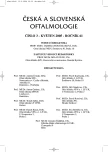-
Medical journals
- Career
Terson’s Syndrome, Pars Plana Vitrectomy and Anatomical and Functional Outcome
Authors: J. Štěpánková 1; J. Dvořák 2; D. Dotřelová 1; E. Klofáčová 2
Authors‘ workplace: Oční klinika dětí a dospělých UK 2. LF a FN Motol, Praha přednosta doc. MUDr. Dagmar Dotřelová, CSc. 1; Oční klinika VFN a 1. LF UK, Praha přednosta doc. MUDr. Bohdana Kalvodová, CSc. 2
Published in: Čes. a slov. Oftal., 61, 2005, No. 3, p. 179-184
Overview
The retrospective case review was aimed to demonstrate anatomical and functional results of pars plana vitrectomy (PPV) in patients with Terson’s syndrome (TS). The most common cause of TS was an acute subarachnoid hemorrhage of ruptured intracranial aneurysm (6 eyes). One patient suffered traumatic subdural and subarachnoid hemorrhage. PPV was performed in 7 eyes of 6 patients (2 women and 4 men). The patients ranged in age from 18 to 53 years (average 37.5 year), the mean age was 37.5 years. The interval between intracranial hemorrhage and PPV varied from 2 to 12 month (average 7.5 months). The visual acuity postoperatively improved in all 7 eyes.The mean period of observation was 12.5 month. Intraoperative complications included retinal break (1) only. Late complications included epiretinal membrane (2), glaucoma (1), cataract (2) and conjunctival cyst (1). Pars plana vitrectomy is highly effective and relatively safe method in hastening visual rehabilitation of adults with Terson’s syndrome.
Key words:
Terson’s syndrome, intracranial hemorrhage, pars plana vitrectomy
Labels
Ophthalmology
Article was published inCzech and Slovak Ophthalmology

2005 Issue 3-
All articles in this issue
- Changes of Physiological Intraocular Pressure (IOP) in Rabbits after Amino Acid Lysine with Antiglaucomatic Drug Latanoprost (Xalatan)
- Transpupillary Thermotherapy in Exsudative Age-related Macular Degeneration. Two-Years Results and Findings on the Other Eye
- The Results of Radiotherapy 24 Months after Treatment by Patients with Agerelated Macular Degeneration
- Perforating Pars Plana Sclerotomy in Idiopathic Uveal Effusion Syndrome
- Terson’s Syndrome, Pars Plana Vitrectomy and Anatomical and Functional Outcome
- Surgical Treatment of Late Tractional Retinal Detachment Appearing on the Basis of Retinopathy of Prematurity
- Use of Ruthenuim 106 in Retinoblastoma Treatment
- Comparison of Accuracy of Refraction Measurement in Children up to the Age of 15 Years by Eccentric Phototrefraction and by Standard Techniques
- Effect of Laser in situ Keratomileusis on LogMAR Visual Acuity and Contrast Sensitivity
- Spontaneous Late Subluxation of Capsule, Intraocular Lens and Capsular Ring in Patient with Pseudoexfoliation Syndrome – a Case Report
- Congenital Stationary Night Blindness (CSNB) – a Case Report
- Czech and Slovak Ophthalmology
- Journal archive
- Current issue
- Online only
- About the journal
Most read in this issue- Terson’s Syndrome, Pars Plana Vitrectomy and Anatomical and Functional Outcome
- Congenital Stationary Night Blindness (CSNB) – a Case Report
- Spontaneous Late Subluxation of Capsule, Intraocular Lens and Capsular Ring in Patient with Pseudoexfoliation Syndrome – a Case Report
- Perforating Pars Plana Sclerotomy in Idiopathic Uveal Effusion Syndrome
Login#ADS_BOTTOM_SCRIPTS#Forgotten passwordEnter the email address that you registered with. We will send you instructions on how to set a new password.
- Career

